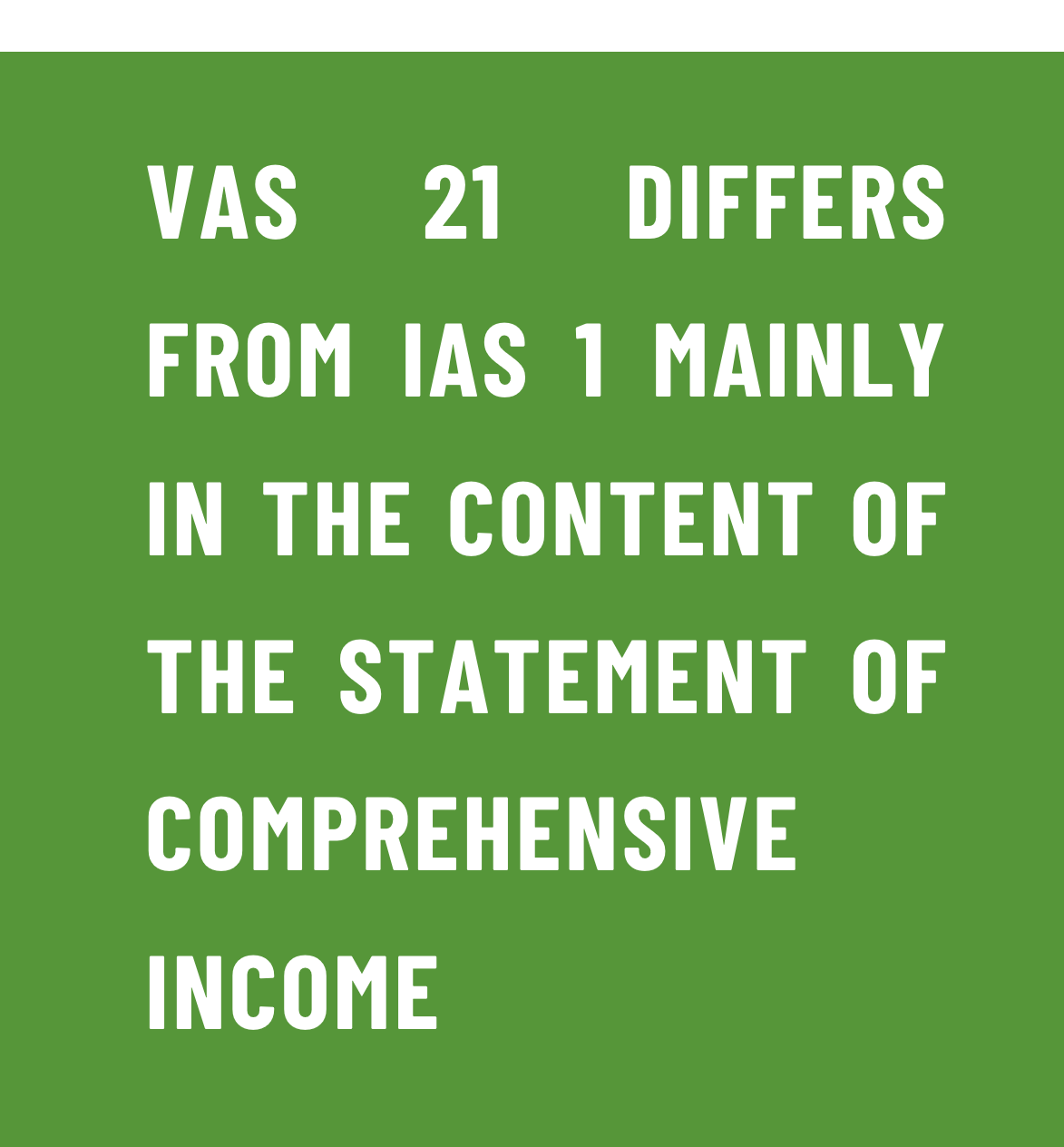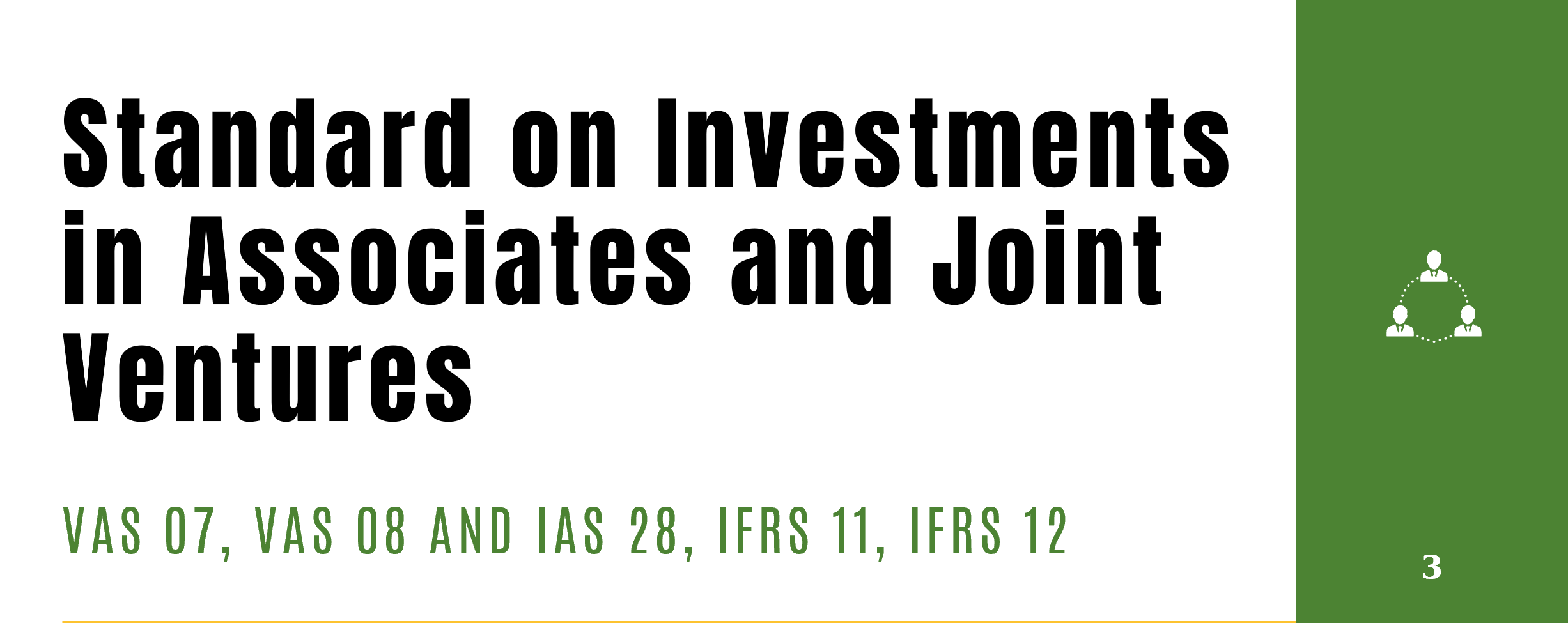
PART 2
Summary of
differences
between VAS
and IFRS



1. Presentation of Financial Statements
2. Business Combinations
3. Accounting for Investments in Associates/Joint Ventures
4. Accounting for Investments in Subsidiaries


STANDARDS
VAS, IAS AND IFRS

1. Standards on Presentation of Financial Statements
(VAS 21 and IAS 1)

2. Standards on Business Combinations
(VAS 11 and IFRS 3)

3. Standards on Investment in Associates and Joint Ventures
(VAS 07, VAS 08 and IAS 28, IFRS 11, IFRS 12)

4. Standards on Consoliated Financial Statements and Accounting for Investments in Subsidiaries (VAS 25 and IFRS 10)





1. The type of income arising from business operations and other activities of the enterprise is recognized in the income statement, such as sales revenue, service provision, income from financial activities, and other income (e.g., income from asset disposal, sale of fixed assets, etc.);
2. The type of income not arising from business operations but mainly due to the enterprise’s revaluation of certain assets, which is therefore not recognized in the income statement but directly recognized in equity, for example:
• Changes in revaluation surplus;
• Gains and losses recognized in employee benefit plans with defined benefits;
• Gains and losses arising from the translation of financial statements of foreign operations;
• Gains and losses from the remeasurement of financial assets available for sale;
• The effective portion of gains and losses on hedging instruments in cash flow hedges.
IAS 1 requires the presentation of the types of income mentioned in point (1) above in a new statement called the ‘Statement of Other Comprehensive Income’ to provide additional information to financial statement users regarding changes in equity that are not related to the company’s profit or loss during the period.


1. Present a single statement divided into two sections: Section 1 – Income Statement; Section 2 – Statement of Other Comprehensive Income; or
2. Present the income statement and the statement of comprehensive income as separate and independent statements. All the issues regarding the format of the statement of comprehensive income mentioned above have not been addressed in VAS 21.



VAS 11 IS BASED ON IAS 22. CURRENTLY, IAS 22 HAS BEEN REPLACED BY IFRS 3.
Some key differences between VAS 11 and IFRS 3 as follows:

According to the provisions of VAS 11, the transaction costs in a business combination over multiple stages are determined as the total costs of each exchange that have not been revalued at fair value at the control date (the acquisition date or the date of completion of the business combination). This causes the company to reflect the business combination transaction costs inaccurately, as the costs of previous acquisitions may differ significantly from the costs at the control date, resulting in this difference not being promptly recognized in the income statement.

Regarding the recognition and determination of goodwill: According to VAS 11, goodwill is only associated with the parent company’s ownership (Part Goodwill), whereas IFRS 3 allows the option to recognize goodwill for both the parent and non-controlling shareholders (Full Goodwill), in addition to recognizing goodwill only related to the parent company’s ownership.
Regarding the determination of goodwill impairment: VAS 11 stipulates that goodwill should be amortized over a maximum period of 10 years, which is technically easy to implement, but fundamentally inappropriate, as the buyer’s advantages, such as management expertise, reputation, and the brand of the acquired company, may not be lost. Therefore, IFRS 3 does not allow goodwill amortization but instead requires annual impairment testing of goodwill.


Regarding investments in associates and joint ventures, VAS currently has two standards: VAS 07 – Accounting for Investments in Associates and VAS 08 – Financial Information on Joint Venture Interests.
In the current IFRS system, there are three standards related to investments in associates and joint ventures, including: the new version of IAS 28, which applies to associates and joint ventures; IFRS 11 – Joint Arrangements; and IFRS 12 – Disclosure of Interests in Other Entities.
The main differences between VAS and IFRS regarding investments in associates and joint ventures are:
1. Scope of application of the equity method
According to IAS 27 – Separate Financial Statements, the equity method can be applied to both the parent company’s separate financial statements and the financial statements of independent entities.
In Vietnam, due to the issuance of VAS 07 15 years ago, the equity method has only been applied to consolidated financial statements. The separate financial statements of companies still apply the cost method.
The equity method provides more useful information than the cost method and aligns with the Enterprise Law, as it requires the presentation of the investment value corresponding to the net assets owned by the investor in the joint venture or associate. Thus, the equity method immediately reflects the impact of the joint venture’s or associate’s operating results on the investor and allows for a more accurate evaluation of the investment’s performance (which the cost method does not do).

2. Recognition of impairment losses
IFRS requires investors to recognize impairment losses on the carrying amount of the investment (beyond the ordinary losses of the joint venture or associate) in accordance with IAS 36, while Vietnam applies provisions for financial investment impairment.
It is worth noting that the provisions for investment impairment in Vietnam (according to Circular 228 and Circular 89) differ significantly from IFRS.



Some key differences between VAS 25 and IFRS 10
CRITERIA FOR DETERMINING CONTROL
IFRS 10 has added several criteria to clearly determine control, which VAS 25 does not address
1. Control over the investee
The investor has control over the investee when the investor exercises rights that allow it to direct activities that significantly affect the investee’s interests. The investor has control even if it has not yet exercised these rights. Evidence showing that the investor has directed the relevant activities may help determine whether the investor has control over the investee. In the absence of such evidence, it may be concluded that the investor does not have control over the investee.
If two or more investors have rights that allow them to unilaterally direct relevant activities, the investor who has the ability to direct the activities that most significantly affect the investee’s interests will have control over the investee. The investor may have control over the investee even when other entities have existing rights that allow them to participate in directing the relevant activities, such as when another entity has significant influence. However, an investor with only protective rights will not have control over the investee.
2. Benefit amounts
The investor has, or has the right to, change the benefits derived from its involvement with the investee when the benefits the investor receives from the involvement are subject to change depending on the performance of the investee.
3. The relationship between control and benefits
The investor controls the investee if the investor not only has the right to control the investee and is exposed to or has the right to change the benefits from its involvement with the investee, but also has the ability to use that control to affect the benefits received from the involvement with the investee.


4. Regarding non-controlling interests
IFRS 10 stipulates that non-controlling interests should be presented as a separate item within equity, while VAS 25 requires non-controlling interests to be presented outside of equity. Non-controlling shareholders remain shareholders of the subsidiary and the group, so the entire ownership portion of the non-controlling shareholders should be presented as an equity item. Therefore, the provisions of VAS 25 are not in line with the nature and current international practices.
Under VAS 25, any loss exceeding the non-controlling shareholders’ portion of the subsidiary’s net assets is attributed to the parent company’s shareholders, and the non-controlling interest on the consolidated balance sheet is always non-negative unless the non-controlling shareholders agree to bear the loss for the parent shareholders. However, as non-controlling interest is an equity item, all shareholders should be entitled to the benefits and bear the corresponding losses according to their ownership stake, regardless of whether they are controlling or non-controlling shareholders. Therefore, the provisions of VAS 25 are not appropriate.

IFRS Auditing and Consulting Company Limited
The company provides a wide range of services such as audit of financial statements, tax advice, accounting services and valuation services with leading experts working in large auditing firms, multinational corporations








